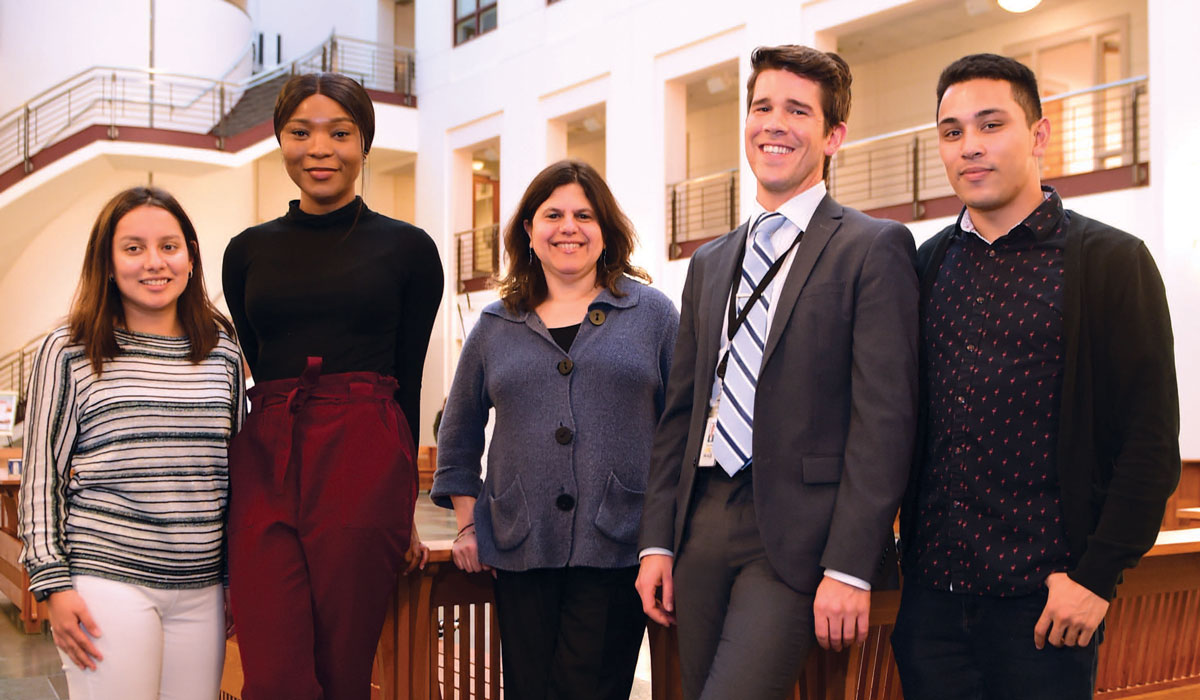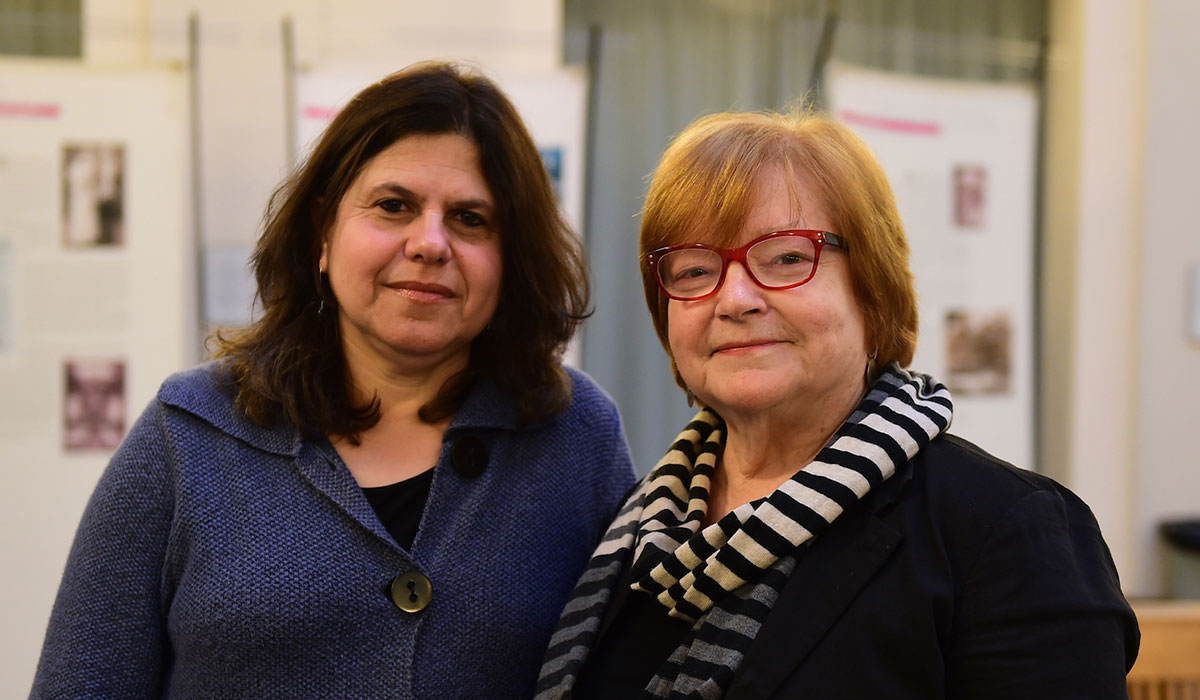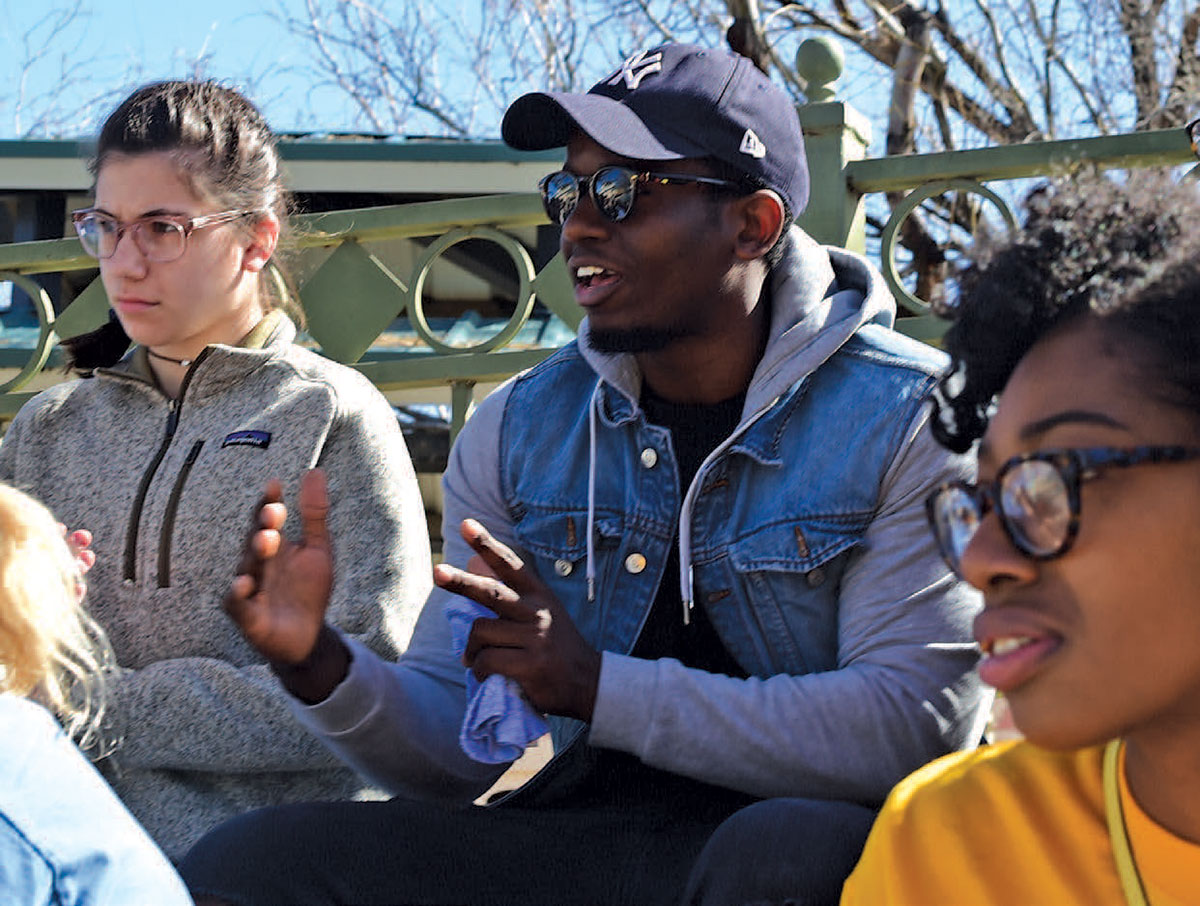

By Ellen N. Woods
Law professors and students representing immigrant clients through the Columbus School of Law clinics show their commitment to social justice.
Second-year law student Kelechi Eke can’t help smiling whenever she thinks of her dad, who passed away a year ago. He came to the U.S. as a professor, and later paved the way for his wife and four children to emigrate from Nigeria. “He single-handedly brought his family to the United States. He wanted us to have opportunities to be successful,” Eke says.
She was 14 when her family settled in Prince George’s County, Md. She became a naturalized citizen while attending the University of Maryland. “My brother is a dentist, one sister is a doctor, and the other is an entrepreneur. I will be the first attorney in the family. And my dad — he is the reason.”
Eke chose to study at Catholic University’s Columbus School of Law, which she calls “a community of faculty and students who are passionate about the role of the legal profession in bringing social justice to vulnerable, marginalized populations.”
Four faculty-run clinics operate through Columbus Community Legal Services (CCLS) to represent low-income clients in civil matters. Eke was naturally drawn to the Immigrant and Refugee Advocacy Clinic (IRAC).
“I know that I was more fortunate than most on my path to citizenship,” she says. “This was a way for me to say to those who are struggling, ‘I hear you, I see you, and I will do my best to help you have a fighting chance.’”
In addition to serving the community, the clinics provide students the experiences that allow them to graduate practice ready. “The clinics teach students to work with clients, prepare affidavits, keep fantastic case files, and appear before a judge,” says Catherine Klein, law professor and director of CCLS, which also includes the Low Income Taxpayer Clinic, the Families and Law Clinic, and the Veteran Advocacy and Estate Planning Clinic. “Perhaps most important, they learn how to value clients, and enter the profession with empathy.”
Stacy Brustin “developed a special connection to immigration issues as a matter of human rights” while a student at Harvard Law School. She’s been a law school faculty member since 1991 and is the director of the IRAC.
While in law school, she was awarded a fellowship to spend three months in Mexico learning about programs to help women in impoverished communities. She used what she learned there during a subsequent yearlong fellowship working with Ayuda, a nonprofit that provides legal and social services to low-income, vulnerable communities. There she created a project to empower survivors of domestic violence.
Brustin is heartened by the energy she sees in her students. “They come here with an interest in public service and a commitment to human rights. In the area of immigration law, there is currently a heightened energy and interest in activism among our students.”
The need for immigration reform is not a new problem, says Brustin. “Past administrations have tried without success to enact wide-ranging immigration reform that allows us to have secure borders, a humane approach to those seeking to enter our country, and a path to citizenship for the many undocumented immigrants who have productively made a home here but live in fear of deportation.
“But now we are living in a time of blatant human rights violations. The Church’s position on the need for humane treatment of immigrants and refugees is clear, and so we feel comfortable at Catholic University standing up and doing more.” By way of example, she points to the “Muslim travel ban” imposed by the then-new Trump Administration in January 2017. “As soon as the ban was announced, our students and a faculty member headed to Dulles International Airport offering legal assistance to desperate travelers whose status had suddenly changed without warning.”
When there are “concerns about the executive or legislative branches engaging in questionable behavior, people look to the judicial branch,” Brustin says. “That’s been really powerful for law students as they see how their skills and knowledge can give those who are in a seemingly hopeless situation a chance at achieving legal immigration status.”
During the spring 2019 semester, Alex Catiggay, a dual-degree graduate student in law and international relations, worked on two bond cases while enrolled in the IRAC. Both of his clients were undocumented immigrants who had been in detention for months due to minor criminal violations. Catiggay, working with Brustin, would be successful in both cases, securing bonds and his clients’ release.
Working on real immigration cases was eye opening, Catiggay says. “I think for many people, they hear about ‘illegals’ and that term alone makes it easy to come to the immigration debate from a place of fear and anger. Reform wouldn’t be impossible if most Americans had the opportunity to put a human face to the debate, to hear the stories.”
Among Catiggay’s clients was an undocumented immigrant from Central America, who came to the U.S. seeking asylum from gang violence and torture. He was walking home from a bar in his neighborhood when he was stopped on the street and charged with public intoxication — a low-level misdemeanor in Virginia, usually punishable by a fine. “Once he could not show legal immigration status, he was put into removal proceedings,” explains Catiggay.

“U.S. citizens are not incarcerated for these types of offenses,” he says. “Yet we have thousands of undocumented immigrants in detention for months and even years for civil, nonviolent offenses.”
Catiggay appeared before a judge and successfully argued his client’s “inability to pay” the high bond, which was reduced to the minimum $1,500. His client also was taken off the detention docket, and transferred to the non-detention docket where he would have more time to prepare his asylum case. “His community came together to raise some of the money, and through the clinic’s connections, additional donations were made to complete the bond,” says Catiggay.

In spring 2019, Catiggay was one of three law students serving in the IRAC who accompanied Brustin on a weeklong trip to the U.S.-Mexico border. The group wanted to learn what drives the people of Mexico and Central American countries to make the dangerous journey to the U.S. border. What is the real story of the border crisis? How could they lend their legal support to the lawyers of Catholic Charities?
At the nation’s southern border in communities such as El Paso, Texas, and Las Cruces, N.M., the Catholic Church is providing a lifeline to those seeking refuge. One of the Church officials leading the charge is Bishop Mark Seitz of the Diocese of El Paso. In his 2017 pastoral letter on migration, “Sorrow and Mourning Flee Away,” he says “brothers and sisters” on either side of the border “wake up each morning to the same beautiful mountains.” It was in the shadow of those mountains that Brustin stood in the Chamizal National Memorial park on a Sunday afternoon in El Paso before heading to Las Cruces, where the Columbus School of Law group was scheduled to begin work the next day.
“It was quiet with just a few people around,” she recalls. “To the side of the park was a large high school. Mexico was so close you could see the poverty on the other side of the border fencing. It was an intense experience. I thought about how just by the accident of one’s birth, by what side of that fence you were born on ….” Her voice trails off.
Third-year law student Maria Lino Callao says the most impactful day for her was when the law school group toured the Otero Detention Center in Chaparral, New Mexico. “Seeing that it was a prison — even though it’s not called that — was shocking for me,” she says. “The detention center had razor-wire fencing and solitary confinement rooms. Detainees could not walk freely and had little recreation. We talked to several who had been there for months with no access to an attorney. They were in crowded cells, yet most posed no violent threat and had committed no criminal offense. Many had a right under U.S. law to seek asylum. Others were guilty of no more than a traffic ticket.”
She is still haunted by the face of one detainee. “I assume he was at least 18 because we were in an adult male detention center. But he looked like he was 14. His eyes were empty with sadness and despair. Thoughts of him stay with me,” says Callao, herself an immigrant from Bolivia.
Daniel Enos, a third-year student and president of the Columbus School of Law Immigration and Refugee Interest Society, can’t forget the staff he met at Catholic Charities Immigration Legal Services of Southern New Mexico. “Their representation of the immigrant community is amazing,” he says. “They were a small professional staff working around the clock and it was so clear they were driven by passion. We were only there a week, but just to be able to assist them by conducting research and working on immigration waiver applications was incredibly rewarding and exhilarating.
“I’ve seen the extreme difference legal representation makes. Without it, most immigrants don’t have a fighting chance to have their cases considered. People’s lives are on the line, and it’s incredible to see the legal community answering the call.”
“With so many people being detained, unable to have their cases heard or to even get bond, the lawyer becomes a beacon of hope,” says Kelechi Eke, now in her second semester with the IRAC. “Their cases are full of emotion. A person fleeing persecution and unimaginable atrocities such as human trafficking, female mutilation, or gang violence does not have the ability to tell that story strictly according to the facts and the law. Because a judge’s time is limited, a lawyer can keep the argument strictly to legal persuasive factors.
“If I had the ability to change just one thing in the immigration crisis, I would want every person seeking legal status to have counsel provided to them. I wish that was mandatory.”
And if Maria Lino Callao had the chance to make one change?
“I would make the process more bearable, more humane,” she says. “We all want reform. I understand there are different perspectives and solutions. But while we debate, we don’t need to have people in prisons. We don’t need to take their children away.”
Humanity is also at the center of the change Professor Klein wishes for. “Most of us came here from some immigration path,” she says. “And when we trace that path, we are likely to find we came from an immigrant group that was once vilified and criminalized. It’s time to stop that cycle. If we could, as a society, stop dehumanizing immigrants and open our hearts, we would be better positioned to find solutions.”

In a Texas shelter for migrant families seeking asylum, first-year law student Patrick Ishimwe and two boys kick a soccer ball. He has broken away from the Catholic University group that is quietly touring the facility in early March as part of a spring break trip to border communities.
The ball flies back and forth in the open space of the warehouse turned-shelter. Ishimwe doesn’t speak the boys’ language but they exchange smiles as easily as they pass the ball. As the student group moves on, he offers a wave and runs off to catch up.
Ishimwe, once a refugee himself, calls soccer an international language. As he moved through different villages in Western Africa, jumping into a soccer game was often the only way he found to be accepted.
In 1994, when Ishimwe was two, his family fled their home during the Rwandan genocide. “We had seconds to grab what we could. My parents thought we would return home to Rwanda one day, but we never did,” he says.
The family landed in a refugee camp in Congo, where they lived for two years. “It was not a place to raise a kid. Every morning we stood on line for food and a blanket,” he says.
Working with the UNHCR (the UN Refugee Agency) Asylum and Refugee Resettlement Program, the family was moved to Kenya, where “we lived in the slums and faced anti-immigrant sentiment from a country that didn’t want Rwandan refugees.” From there, they moved to Togo, where they lived for 10 years. Then in 2009, through the resettlement program, they were placed in Buffalo, N.Y.
The family still lives there, now as U.S. citizens. “It was a culture shock in so many ways, including language barriers and racism,” Ishimwe says. “But at first, the biggest shock was the weather. As a kid coming from West Africa, I had to wear three jackets at once to stay warm — and that was in September!” The family of seven often had help on their journey to America. “Because my father is a pastor, missionary communities assisted at nearly every turn,” he says. “When you’ve had people looking out for you, you want to open doors for others. My whole family feels that it would be selfish not to give back.”
Ishimwe’s pastor father works in mental health, his mother in social services. His older sister helped raise the younger children while their parents worked. His older brother is in medical school and his younger brother works for the international charity Operation Christmas Child. The youngest daughter is a senior in high school.
Ishimwe graduated from Houghton College in Western New York with a degree in political science and international development. Drawn to public service, he worked for local government as an advocate for low-income communities.
At age 27, he came to the Columbus School of Law with an interest in immigration law. During his spring break this year, he accompanied Law Professor Stacy Brustin and five other students working in the Immigration and Refugee Advocacy Clinic to offer legal assistance to Catholic Charities of Southern New Mexico. They spent most days in a small conference room helping with research on asylum cases.
“Law school is full of long nights in the library,” he says. “The trip to the border was motivating. It was a reminder that there will be a payoff to what we do.”
During moments outside the conference room, such as when the group toured the shelter, Ishimwe was reminded of his own refugee experience. He believes his adopted country can do better. “In the United States, we are led to believe there is a choice between our safety and our ideals. That’s a false choice. We can still be that shining city on the hill that welcomes people.”